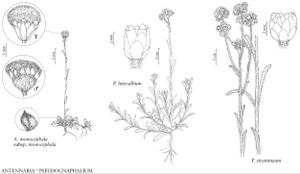Antennaria monocephala subsp. monocephala
Dioecious (staminates and pistillates in equal frequencies in populations). Stems stipitate-glandular. Basal leaves narrowly spatulate to oblanceolate, mostly abaxially tomentose, adaxially green-glabrous to glabrescent, sometimes both gray-pubescent. 2n = 28.
Phenology: Flowering summer.
Habitat: Moist tundra, often on disturbed margins of solifluction lobes or on unstable, gravelly slopes
Elevation: 0–1800 m
Distribution

B.C., N.W.T., Yukon, Alaska, Russian Far East (Chukotka Peninsula)
Discussion
E. Hultén’s (1968) key distinctions between subsp. monocephala and subsp. philonipha are obscure and seemingly arbitrary (R. J. Bayer 1991). Antennaria exilis is a pubescent form of A. monocephala; complete intergradation occurs between the forms. Taxonomic recognition for the two forms does not seem warranted. Antennaria monocephala subsp. monocephala is the diploid progenitor of the apomictic clones that make up subsp. angustata, and a progenitor of the A. alpina agamic complex.
Selected References
None.
